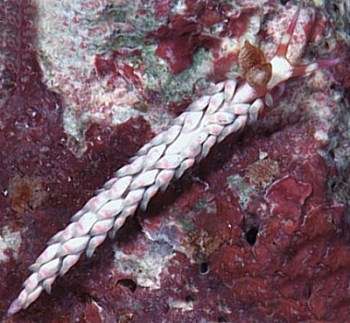
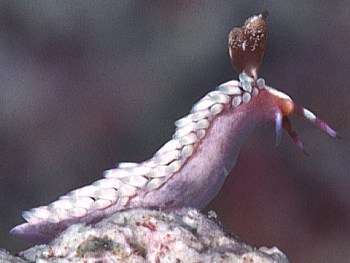
Babakina cf. festiva
Order: NUDIBRANCHIA
Suborder: AEOLIDINA
Family: Glaucidae
PHOTO
Kerama Is.[near Okinawa], Japan. 6m depth, July 1999, 10mm long. PHOTO: Atsushi Ono.
Similar to Babakina festiva (Roller, 1972) but see Terry Gosliner's message below.
See also message [#17134] discussing Babakina anadoni.
Authorship detailsRudman, W.B., 1999 (September 10) Babakina cf. festiva [In] Sea Slug Forum. Australian Museum, Sydney. Available from http://www.seaslugforum.net/find/babacffe
Related messages
Re: Babakina festiva ? from Spain
July 15, 2006
From: Javier Santiago Caamaño
Concerning message #17092:
Dear Bill
I have been sent a reference to a photo identified as Babakina anadoni which looks very like the one I sent to you and you kindly identified as Babakina. The reference is: http://www.geocities.com/joseaugustosilva/worldaround/mnudibranches30g.html Is it possible that it is also a variety of Babakina festiva.?
Muchas gracias.
Javier Stgo.
javisan@edu.xunta.es
Caamaño, J.S., 2006 (Jul 15) Re: Babakina festiva ? from Spain. [Message in] Sea Slug Forum. Australian Museum, Sydney. Available from http://www.seaslugforum.net/find/17134Dear Javier Santiago,
Thanks for reminding me about Babakina anadoni, which was first described from the Atlantic coast of Spain. Your animal is obviously the same, as is the one in Vincius Padula's message [#15404]. from Brazil, and Colin Redfern's from the Caribbean [#6695]. At present there doesn't seem to be any clear anatomical differences between the Atlantic specimens and the Pacific forms. In colour, the only real difference is that Atlantic animals seem brighter in colour but we really haven't enough material to know whether this is a consistent difference or not.
My feeling is that they will all turn out to be single species which has spread globally by shipping, but I have no idea where its original home was. So you have a choice of calling your animal Babakina anadoni or Babakina cf. festiva or even Babakina festiva. Whatever you decide to do, the important thing to know is that this is one of the many areas of our science where we can't give a definite answer.
-
Ortea, J.A. (1979) Nota preliminar sobre Rioselleolis anadoni n.gen., n.sp., un nuevo Aeolidaceo (Mollusca: Opisthobranchia) capturado en Ribadesella, Asturias, Espana. Boletin I.D.E.A. Supl. Cienc, 24: 131-141, pls.1-2.
-
Rolan, E., Rolan-Alvarez, E., & Ortea, J. (1991): On the report in Galicia (NW Spain) of Tritonia hombergi Cuvier, 1803 and Babakina anadoni (Ortea, 1979) comb. nov. (Mollusca: Nudibranchia). Iberus 10(1): 113-117.
Best wishes,
Bill Rudman
Babakina festiva ? from Spain
July 11, 2006
From: Javier Santiago Caamaño
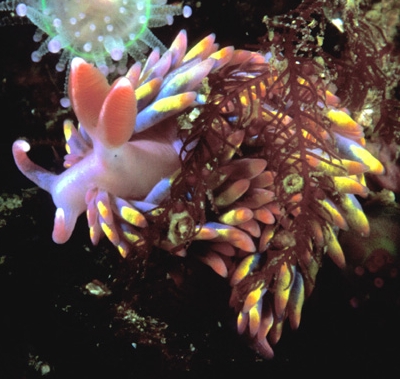
Dear friends,
Here is a photo of a species that looks like Berghia coerulescens but it has a slightly different coloration. The photo was made in Galicia at a depth of 15 M at the Island of Sálvora (National Park of the Atlantic Islands of Galicia).
Locality: Isla de Sálvora, 15 m, Galicia (NW Spain), Atlántic Ocean, 24 June 2006, rocky substrate; zone moderately exposed. Length: 15 mm aproximadamente. Photographer: Javier Santiago Caamaño.
Thank you very much.
Javier Santiago.
javisan@edu.xunta.es
Santiago Caamaño, J., 2006 (Jul 11) Babakina festiva ? from Spain. [Message in] Sea Slug Forum. Australian Museum, Sydney. Available from http://www.seaslugforum.net/find/17092Dear Javier,
This is an interesting find, It is an animal which we are tentatively calling Babakina festiva. As you will see from the other messages on this species, it is either a worldwide species, or there are a number of geographically separated species all with very similar external shape and colour. One of the most distinctive features is the way the rhinophores are joined at the base into a single stalk.
In an earlier message Terry Gosliner mentions that he and Lucas Cervera have found this 'species' in Spain [message #1324], but it is good to see a photograph of an animal from the east Atlantic. It certainly looks similar to photos on the Forum from the Caribbean and Brazil. Babakina festiva (Roller, 1972) was originally described from California, but similar animals have since been found in Japan, New Zealand, and both sides of the Atlantic. The only other one that has been named is B. caprinsulensis from New Zealand. It is possible that they are all forms of a single species which has been transported around the world by shipping.
Best wishes,
Bill Rudman
Babakina festiva from Brazil
December 6, 2005
From: Vinicius Padula
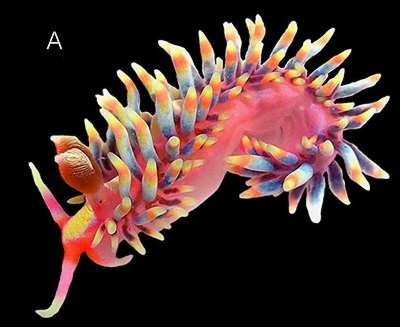
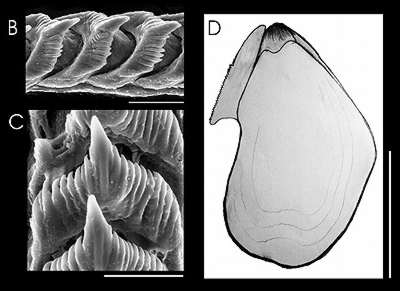
Dear Bill,
I send to the Forum photos of Brazilian Babakina festiva and details of radula and jaw. The Brazilian colour form is very similar to the animals found in the Bahamas and illustrated in Colin Redfern´s book.
As you said on the Babakina caprinsulensis page it´s doubtful if all geographic forms find in California, Japan, South Korea, New Zealand, Bahamas and now in Brazil are the same species. Maybe Caribbean and Brazilian animals are a another species. New anatomical and molecular studies are necessary to confirm the real identification of this group.
Photos of 17 mm specimen collected in 1m at Praia das Conchas, Rio de Janeiro on September 26, 2004. A: live (by Vinicius Padula). B, C: SEM of radula. Scale bar - 50 µm. D:drawing of jaw, Scale bar - 0.5 mm (by Vinicius Padula).
-
Padula, V. & Absalão, R.S. (2005) Primeiro registro de Babakina festiva (Roller, 1972)(Mollusca: Nudibranchia) no Atlântico Sul. Biociências, 13(1): 99-101.
Best wishes,
Vinicius Padula
viniciuspadula@yahoo.com
Padula, V., 2005 (Dec 6) Babakina festiva from Brazil. [Message in] Sea Slug Forum. Australian Museum, Sydney. Available from http://www.seaslugforum.net/find/15404Dear Padula,
Thanks for this interesting addition to our knowledge of this 'species'. What I said before was not that I was doubtful but rather that 'It is possible that all these are geographic variants of a single species'. Although the apparent difference between your brightly coloured animal and the relatively dull New Zealand 'species', they all show traces of the same colour pattern, and all have the strange rhinophores on a combined stalk. Perhaps something in their biology has made them able to 'hitchhike' around the world like so many polycerids have.
Best wishes,
Bill Rudman
Babakina festiva (Roller 1972) from Sth Korea
March 23, 2005
From: Dong Bum Koh
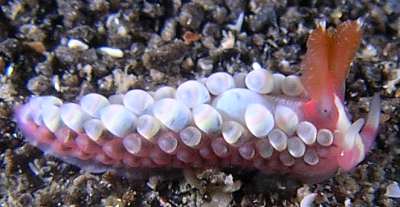
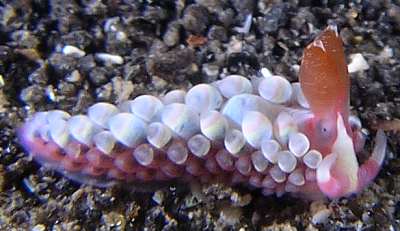
Dear Bill,
I would like introduce Babakina festiva (Roller 1972) for your Forum.
It's measured 8 mm in total length & 3 mm in height. It was taken during night diving in Seong San in Jeju island.
Locality: Seong San Beach, Jeju Island, South Korea. Depth: 7 m. Length: 8 mm. 23. Oct. 2004. Small fishery harbor. Photographer: Byung Ro Youn
Best wishes,
Dong Bum Koh
drkoh@seasee.co.kr
Koh, D.B., 2005 (Mar 23) Babakina festiva (Roller 1972) from Sth Korea. [Message in] Sea Slug Forum. Australian Museum, Sydney. Available from http://www.seaslugforum.net/find/13404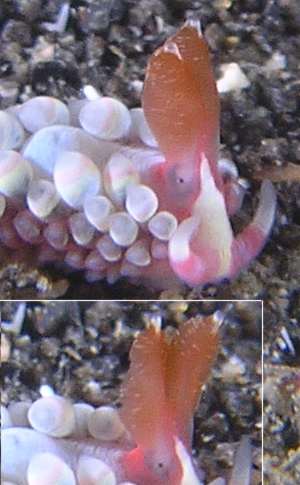
Dear Koh,
Thanks for these interesting photos which arived while I was preparing a message about Babakina caprinsulensis, which may be the same species from New Zealand. I have been accumulating examples of this species as Babakina cf. festiva as Terry Gosliner said there was a project on these animals under way to see if there was one or more species. Your animals certainly look very similar to those on the Forum from Japan.
Best wishes,
Bill Rudman
Babakina cf. festiva from the Bahamas
April 15, 2002
From: Colin Redfern
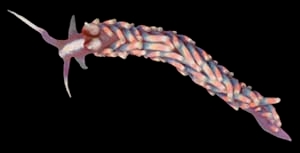
Dear Bill,
Following your comments on the variability of this species, these are photos of what I have been calling Babakina festiva from the Bahamas. This 10mm specimen was collected from Cladophora in 1m at Thurstone Bay, Abaco, Bahamas on June 29, 1999. Photos are from plate 121 of Bahamian Seashells.
Best wishes,
Colin
bahamianseashells@att.net
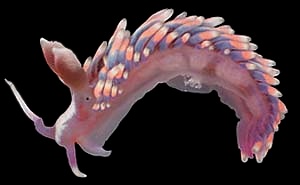
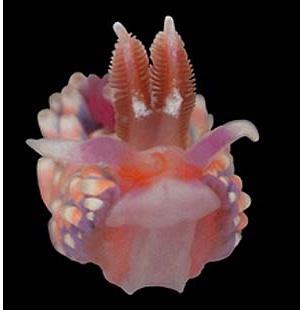
Thanks Colin,
It is certainly an interesting species, or group of species. I first used to wonder why the rhinophores stalks were fused together, but now that I have seen more photos of it, it seems the reason they are fused is that it is the only way they can fit on the back of the animal. The question we should be wondering about is why are the rhinophores so big. I used to think they were drawn a bit large in illustrations so we could see the fused stalks more clearly, but as the photos confirm, when you compare them with other aeolids, they are certainly large for the size of the animal.
Best wishes,
Bill Rudman
Babakina cf. festiva from Japan
April 6, 2002
From: Nishina Masayoshi
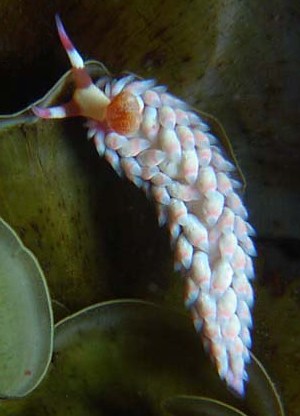
Dear Bill,
I would like you to introduce Babakina cf. festiva from Hachijyo Island and Omijima Island, Yamaguchi pref., Japan
UPPER RIGHT, LOWER RIGHT: Hachijyo Island, Length is 20mm. Photo: Jun Imamoto.
LOWER LEFT: Oumijima Island, Length: 40mm. Photo: K. Mika.
K. Mika mentioned that Babakina cf. festiva there grows up to 60mm at max.
Best Regards,
Nishina Masayoshi
http://umiushi.zive.net/index.html
nishina@wips.co.jp
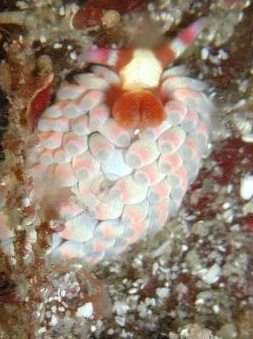
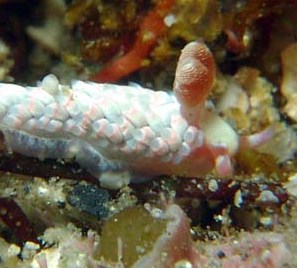
Dear Nishina,
Thanks very much. Your photos show the strange rhinophores with the common basal stalk very clearly. In Terry Gosliner's message he discussed the need to know how much variation there was between animals from different parts of the world. It appears that the colour pattern of the Japanese population shows very little variation.
Best wishes,
Bill Rudman
Re: Unknown aeolid from Kerama Island
September 26, 1999
From: Shino Futatsugi
Dear Bill.
Thank you for your immediate reply. The animal I saw was exactly the same color as Atsushi's photo so I could easily identify it. I hope this imformation to be useful.
Best regards,
Shino
shino-f@pobox.com
Futatsugi, S., 1999 (Sep 26) Re: Unknown aeolid from Kerama Island. [Message in] Sea Slug Forum. Australian Museum, Sydney. Available from http://www.seaslugforum.net/find/1371Re: Unknown aeolid from Kerama Island
September 25, 1999
From: Shino Futatsugi
Dear all, I am an amateur diver in Tokyo. This is my first appearance in this site.
I saw the same animal in last August at Oshima island, located 100km south of Tokyo. The animal was found at 3m deep, crawling behind hydroids. Water temperature was 23C and the length of the animal was 15mm.
I thought that was a juvenile of Pteraeolidia ianthina.
I also will be happy to have its correct name.
Shino Futatsugi
shino-f@pobox.com
Futatsugi, S., 1999 (Sep 25) Re: Unknown aeolid from Kerama Island. [Message in] Sea Slug Forum. Australian Museum, Sydney. Available from http://www.seaslugforum.net/find/1370Dear Shino,
Welcome to the Forum. As you will see from Terry Gosliner's message, Babakina festiva is either a very variable species, or else there are a number of related species in different parts of the world. It would perhaps be useful to know how much variation in colour is found in animals from Japan. Was your animal exactly the same colour as Atsushi's photo?
Best wishes,
Bill Rudman.
Re: Aeolid from Kerama Is
September 11, 1999
From: Terry Gosliner
Dear Bill,
The animal that Atsushi sent is a species of Babakina. We have been calling it Babakina festiva, but we need to look at this weird group of aeolids from all over the world to see if they represent a single species. The animal in Atsushi's photo looks just like a specimen that I collected in the southern Philippines. Other animals from Japan, California and Spain look a bit different. Lucas Cervera and I are hoping to be able to conduct the work to answer some of these questions.
All the best,
Terry
tgosline@calacademy.org
Gosliner, T., 1999 (Sep 11) Re: Aeolid from Kerama Is. [Message in] Sea Slug Forum. Australian Museum, Sydney. Available from http://www.seaslugforum.net/find/1324Thanks Terry,
I'm glad you Californians are keeping alert! I must say after looking at the published photos, and Roller's description, that I wouldn't have guessed this was related to Babakina festiva. In the two editions of Dave Behrens' pacific Coast Nudibranchs the colours are much more intense and the rhinophores don't seem to be as large rhinophores as in Atsushi's photo. Are these the sort of variations you plan to look at?
Bill Rudman.
Re: Unknown aeolid from Kerama Island
September 11, 1999
From: Ron Velarde
Dear Dr. Rudman,
The photo of the unknown aeolid from Kerama Island looks like Babakina festiva (Roller, 1972). See Behrens (1991) and Roller (1972). It was originally descibed from specimens from off southern California but was also noted as occurring off Japan.
I really enjoy the Forum and seeing branchs from around the world.
Keep up the good work!
Ron Velarde
rgv@sdcity.sannet.gov
Velarde, R., 1999 (Sep 11) Re: Unknown aeolid from Kerama Island. [Message in] Sea Slug Forum. Australian Museum, Sydney. Available from http://www.seaslugforum.net/find/1325Thanks Ron,
As I just remarked to Terry Gosliner, we needed someone who knew the living animal to identify it.
Bill Rudman.
Unknown aeolid from Kerama Island
September 10, 1999
From: Atsushi Ono


Dear Bill,
Thank you very much for identifying my animal as probably Nembrotha livingstonei.
I found this unique Aeolid at Kerama Is.[near Okinawa]in Japan.This species is considered to be very rare here as I saw only one individual in 3 years.
It has blurred pink-patches on the cerata, and big brown rhinophores. It looks like a braided rope.
I found this at 6m depth, in July. 10mm long.
Sincerely,
Atsushi Ono
ononini@cosmos.ne.jp
Ono, A., 1999 (Sep 10) Unknown aeolid from Kerama Island. [Message in] Sea Slug Forum. Australian Museum, Sydney. Available from http://www.seaslugforum.net/find/1314Dear Atsushi,
What a remarkable animal. I could only make a guess at the family it belongs to, and then would most probably be wrong. We would need to look at its anatomy to have any idea of its relationships. I wonder why its rhinophores, are disproportionally large?
Bill Rudman.
Rudman, W.B., 1999 (Sep 10). Comment on Unknown aeolid from Kerama Island by Atsushi Ono. [Message in] Sea Slug Forum. Australian Museum, Sydney. Available from http://www.seaslugforum.net/find/1314